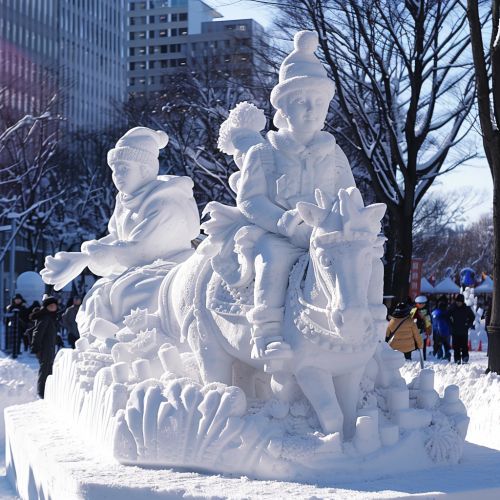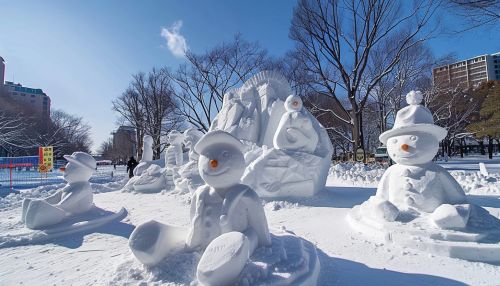Sapporo Snow Festival: Difference between revisions
(Created page with "== Overview == The Sapporo Snow Festival, known as Sapporo Yuki Matsuri (さっぽろ雪まつり) in Japanese, is an annual event held in Sapporo, the capital city of Hokkaido, Japan. The festival is renowned for its stunning snow and ice sculptures, which attract millions of visitors from around the world. It typically takes place over seven days in February and features large-scale sculptures, intricate designs, and various winter activities. == History == The orig...") |
No edit summary |
||
| Line 15: | Line 15: | ||
Odori Park is the main venue, stretching 1.5 kilometers through the heart of Sapporo. It features the largest and most elaborate snow sculptures, some reaching heights of up to 15 meters. The park is divided into several blocks, each showcasing different themes and designs. | Odori Park is the main venue, stretching 1.5 kilometers through the heart of Sapporo. It features the largest and most elaborate snow sculptures, some reaching heights of up to 15 meters. The park is divided into several blocks, each showcasing different themes and designs. | ||
[[Image:Detail-91707.jpg|thumb|center|Snow sculptures in Odori Park during the Sapporo Snow Festival.|class=only_on_mobile]] | |||
[[Image:Detail-91708.jpg|thumb|center|Snow sculptures in Odori Park during the Sapporo Snow Festival.|class=only_on_desktop]] | |||
=== Susukino === | === Susukino === | ||
Latest revision as of 00:41, 20 June 2024
Overview
The Sapporo Snow Festival, known as Sapporo Yuki Matsuri (さっぽろ雪まつり) in Japanese, is an annual event held in Sapporo, the capital city of Hokkaido, Japan. The festival is renowned for its stunning snow and ice sculptures, which attract millions of visitors from around the world. It typically takes place over seven days in February and features large-scale sculptures, intricate designs, and various winter activities.
History
The origins of the Sapporo Snow Festival date back to 1950 when local high school students built six snow statues in Odori Park. The event quickly gained popularity, and by 1955, the Japan Self-Defense Forces from the nearby Makomanai base joined in, contributing larger and more elaborate sculptures. The festival continued to grow, and by the 1970s, it had become an international event, drawing participants and visitors from various countries.
Locations and Venues
The festival is primarily held at three main sites: Odori Park, Susukino, and Tsudome.
Odori Park
Odori Park is the main venue, stretching 1.5 kilometers through the heart of Sapporo. It features the largest and most elaborate snow sculptures, some reaching heights of up to 15 meters. The park is divided into several blocks, each showcasing different themes and designs.


Susukino
Susukino, Sapporo's entertainment district, hosts the Susukino Ice World, where visitors can view intricate ice sculptures. The ice sculptures are illuminated at night, creating a magical atmosphere. This site also includes an ice bar and various ice-related activities.
Tsudome
Tsudome is a family-friendly site located a short distance from the city center. It features snow slides, snow rafting, and other winter activities. The indoor dome area provides a warm space for visitors to enjoy food stalls and entertainment.
Sculpture Creation
The creation of snow and ice sculptures is a meticulous process that involves months of planning and preparation. Teams of artists and engineers work together to design and construct the sculptures. The snow used is often transported from surrounding areas to ensure the right consistency and quality.
Design and Planning
Designing the sculptures begins months in advance. Artists create detailed sketches and models, which are then reviewed and approved by the festival committee. The designs range from traditional Japanese motifs to contemporary themes and famous landmarks.
Construction
Construction begins in late January, with teams working around the clock to complete the sculptures in time for the festival. The process involves stacking and compacting snow into large blocks, which are then carved and shaped using various tools. Ice sculptures are created using blocks of ice, which are cut and assembled like a puzzle.
Cultural Significance
The Sapporo Snow Festival holds significant cultural importance in Japan. It not only showcases the artistic talents of the participants but also celebrates the winter season and the unique climate of Hokkaido. The festival fosters a sense of community and collaboration, bringing together people from different backgrounds to create something beautiful.
Economic Impact
The festival has a substantial economic impact on Sapporo and the surrounding region. It attracts millions of tourists, generating revenue for local businesses, hotels, and restaurants. The influx of visitors also boosts the local economy by creating jobs and supporting various industries.
Environmental Considerations
The festival organizers are increasingly mindful of the environmental impact of the event. Efforts are made to minimize waste and promote sustainability. For instance, the snow used for the sculptures is often recycled, and eco-friendly materials are used for construction and decorations.
